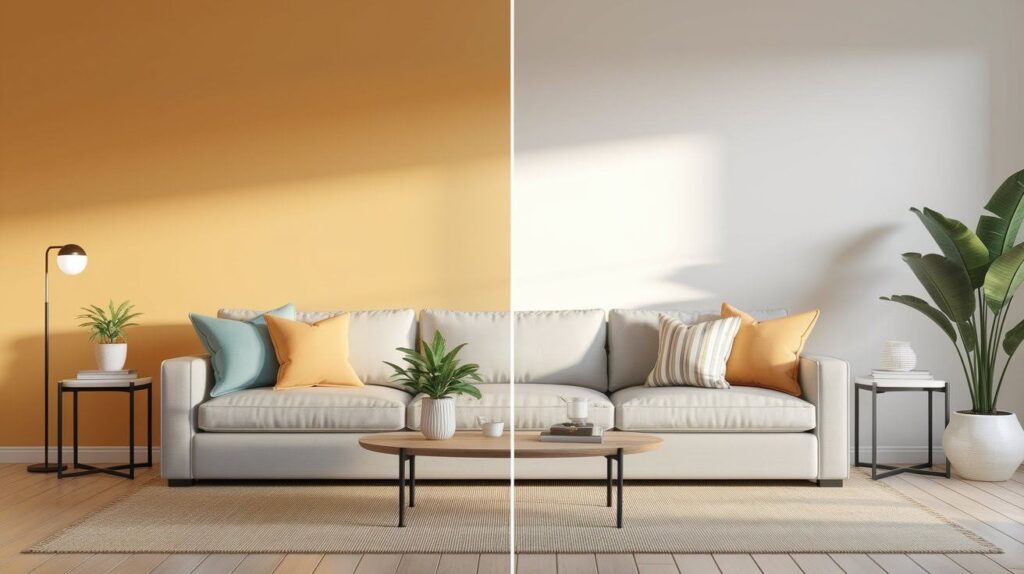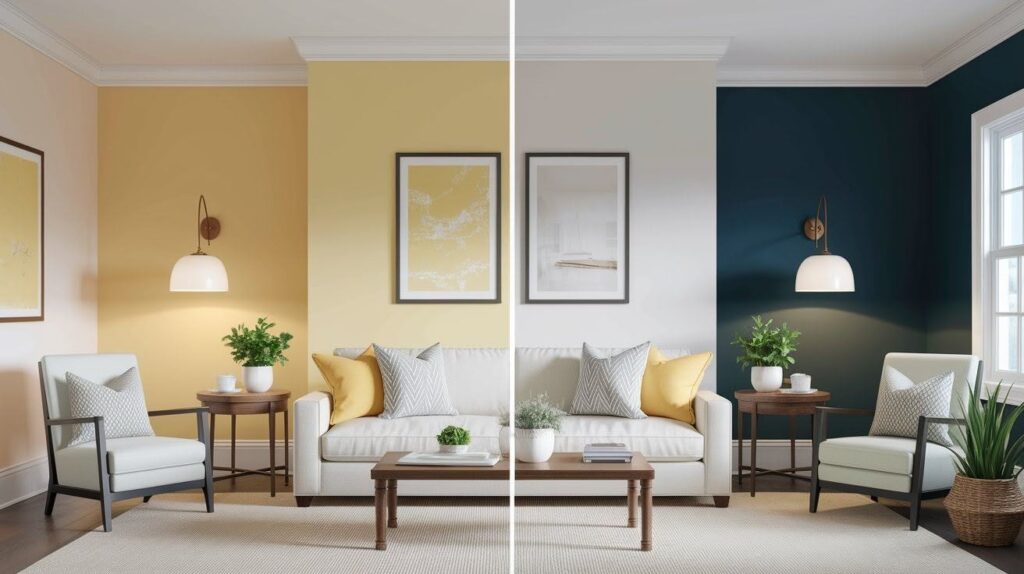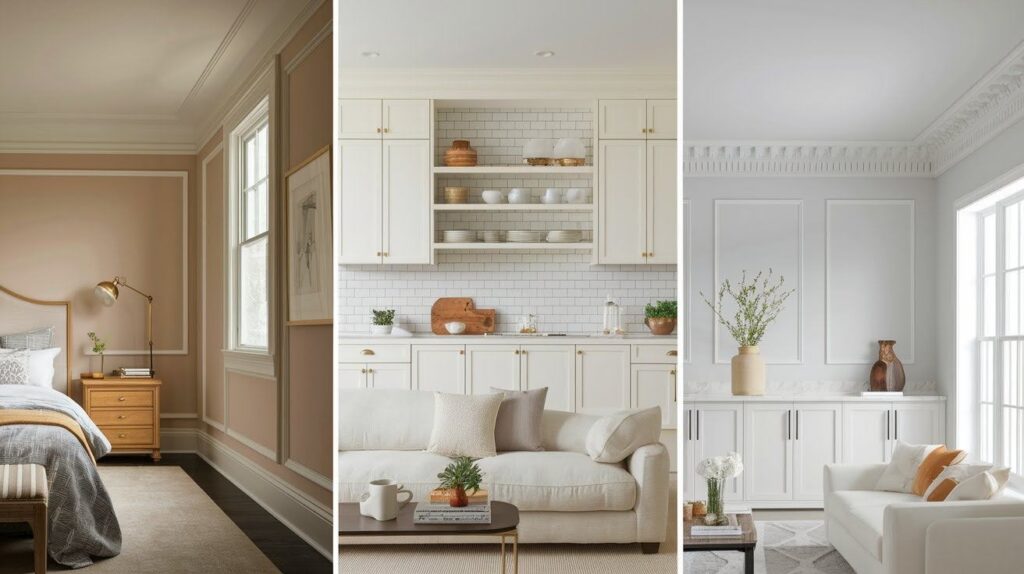Choosing the perfect white paint feels deceptively simple until you’re standing in the paint aisle, overwhelmed by dozens of “white” options that all look remarkably different.
After years of working with clients, I’ve seen two names consistently rise to the top: Benjamin Moore’s Simply White and Sherwin-Williams’ Pure White.
Both have earned their reputation as go-to neutrals, but they each bring distinct characteristics that can make or break your space.
The difference lies in the details – those subtle undertones, how they respond to lighting, and which rooms they truly shine in.
This guide breaks down everything you need to know about these two popular choices, including their undertones, lighting conditions, ideal applications, and honest assessments of their strengths and limitations.
Simply White vs Pure White: A Quick Comparison
When clients ask me about these two whites, I always start with the basics. Here’s how they stack up side by side:
| Feature | Benjamin Moore Simply White (OC-117) | Sherwin-Williams Pure White (SW 7005) |
| Brand | Benjamin Moore | Sherwin-Williams |
| LRV | 89.52 (very bright) | 84 (slightly less bright) |
| Undertones | Yellow warmth | Subtle warm neutrality |
| Best Uses | Living rooms, bedrooms, traditional homes | Open concepts, modern spaces, versatile applications |
Benjamin Moore Simply White (OC-117)
This paint brings serious brightness to any room. With an LRV of 89.52, it reflects almost 90% of available light.
The yellow undertones give it that cozy, lived-in feeling that makes spaces feel welcoming rather than cold. It works best in traditional settings where you want warmth and comfort.
Sherwin-Williams Pure White (SW 7005)
Pure White sits at an LRV of 84, still bright but with a touch more depth. Its subtle warm undertones make it incredibly adaptable.
This color works well in modern homes and open floor plans where you need consistency across multiple rooms.
The difference becomes clear when you see them in actual spaces. Simply White feels like a warm hug. Pure White feels fresh and clean.
Why Undertones Matter in White Paint

The Role of Undertones in Simply White
Simply White carries yellow undertones that add warmth but can shift to creamy in certain lighting conditions. Morning light enhances the yellow beautifully, while afternoon sun can push it toward cream.
Evening artificial light makes the yellow more noticeable, creating a cozy effect that some love and others find too yellow.
The Role of Undertones in Pure White
Pure White has minimal undertones, making it incredibly stable and balanced across different lighting throughout the day.
It looks consistent from morning to night and works with different light bulbs without dramatic shifts. This stability means it pairs easily with other colors since you won’t fight competing undertones.
How Lighting Affects Simply White vs Pure White

Lighting can make or break your white paint choice. I’ve seen the same color look completely different in rooms just down the hall from each other.
North-facing rooms with cooler light can make Simply White look flat or gray, while Pure White stays clean and bright.
South-facing rooms with warm sunlight bring out Simply White’s yellow undertones beautifully, though it might look too creamy during peak afternoon hours. Pure White stays balanced in any natural light condition.
Artificial Lighting: Incandescent, LED, and Mixed Light
Incandescent bulbs: bring out the yellow in Simply White dramatically. What looked perfect during the day can suddenly feel too warm at night. Pure White stays neutral under these bulbs, maintaining its clean appearance.
LED lights: vary widely in color temperature. Warm LEDs will push Simply White toward cream, while cool LEDs might make it look dingy. Pure White adapts to both without major shifts.
Mixed lighting: It creates the biggest challenge. Rooms with recessed LEDs plus table lamps can make Simply White look inconsistent across different areas. Pure White handles this combination much better, staying uniform throughout the space.
Where to Use Each Color in Your Home

For Walls
Simply White creates cozy, welcoming spaces perfect for bedrooms and traditional living rooms. The yellow undertones add warmth that makes rooms feel lived-in and comfortable.
Pure White gives you crisp, clean backdrops ideal for modern spaces and open floor plans. It maintains consistency across multiple rooms without feeling cold or sterile.
For Trim and Molding
Pure White is almost always the better choice for trim work throughout your home. Its neutral undertones look cleaner against any wall color you choose.
Simply White’s yellow notes can clash with cooler wall tones like grays and blues. Professional painters often stick with Pure White for all trim to avoid color conflicts.
For Kitchen Cabinets
Simply White brings traditional warmth that pairs well with natural materials and brass hardware. It complements subway tile and farmhouse-style kitchens beautifully.
Pure White offers modern neutrality that works with any countertop or backsplash choice. It adapts to marble, quartz, or butcher block without fighting your other design elements.
Match the paint to the mood you want in each space. Cozy and traditional? Simply White. Clean and modern? Pure White.
How to Decide: Simply White or Pure White?

Choose Simply White If You
You love cozy warmth in your living spaces and have plenty of natural light. You prefer traditional, farmhouse, or cottage-style interiors with warm materials like natural wood and brass fixtures.
Choose Pure White If You
You want clean, neutral walls that work with any decor style. Your home has a modern design, and you need consistency across open floor plans.
Still unsure? Get sample sizes of both colors and paint large swatches on your walls. Live with them for a few days under different lighting conditions.
The right choice will feel obvious once you see it in your actual space.
Trust your instincts. The white that makes you smile when you walk into the room is the right one for your home.
Pros and Cons of Simply White vs Pure White
Simply White Pros and Cons
Pros:
- Creates warm, inviting spaces that feel comfortable
- Works beautifully in traditional and farmhouse homes
- Complements natural wood and warm materials
Cons:
- It can look too creamy in certain lighting
- Doesn’t pair well with cool colors like grays
- Less versatile for modern spaces
Pure White Pros and Cons
Pros:
- Stays consistent across different lighting conditions
- Works with both warm and cool accent colors
- Perfect for modern and open floor plans
Cons:
- May feel too neutral for those wanting warmth
- It can look stark without enough natural light
- Less forgiving of wall imperfections
Conclusion
After years of helping homeowners choose between these two popular whites, it always comes down to one simple question: Do you want warmth or neutrality?
Simply White brings that cozy, traditional feel with its yellow undertones, while Pure White offers clean versatility that adapts to any style. But here’s what I’ve learned matters most – seeing both colors in your actual space.
Paint those swatches. Live with them for several days. Watch how they change from morning coffee to evening dinner. The right white will feel like home the moment you see it.
When you’re ready to make your final decision, consider working with a professional painting company.
They bring the experience to help you choose confidently and the skills to ensure your new white looks perfect on every wall.
Frequently Asked Questions
Which white paint is brighter, Simply White or Pure White?
Simply White is brighter with an LRV of 89.52 compared to Pure White’s 84. However, Pure White often appears more consistent in brightness throughout the day due to its stable undertones.
Do Simply White and Pure White look the same in all lighting?
No, they react very differently to lighting changes. Simply White’s yellow undertones shift more dramatically, while Pure White stays consistent across various lighting conditions.
Which white works better for kitchen cabinets?
It depends on your style preference and kitchen design. Simply White suits traditional kitchens with warm materials, while Pure White works better for modern kitchens and pairs with any countertop.
Can I use both whites in the same house?
Yes, many homeowners use Simply White in cozy spaces like bedrooms and Pure White for trim or modern areas. Just ensure the transition feels intentional rather than accidental.
Should I test paint samples before deciding?
Absolutely, and this step is crucial for white paint selection. Paint large swatches and observe them for several days under different lighting conditions to see how each white truly looks in your space.

